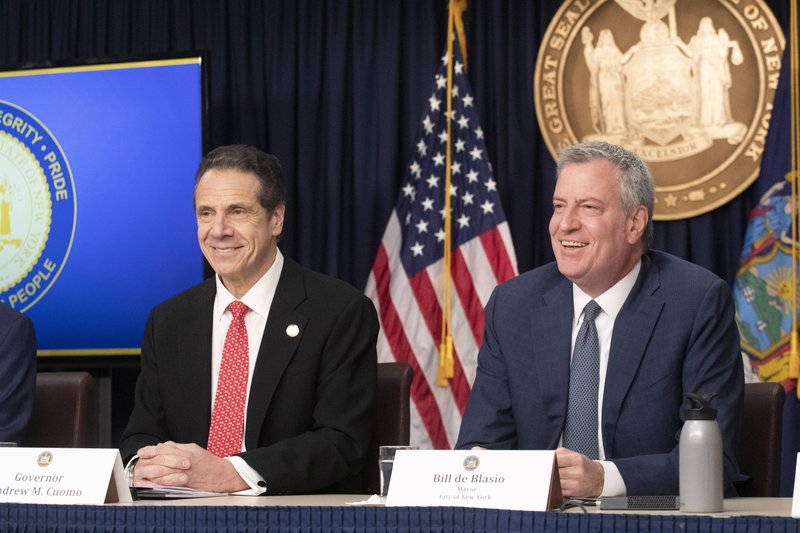A dangerous virus has transformed New York as it has claimed the lives of 10,000 people, but one thing hasn’t changed: the contentious relationship between the state’s two most prominent politicians, Gov. Andrew Cuomo and New York City Mayor Bill de Blasio.
A weekend dust-up over which of the two Democrats gets to say when New York City students can return to school was just the latest example of Cuomo tussling with de Blasio over who is in charge of the state’s and nation’s most populous city.
De Blasio, who closed school buildings a month ago, announced Saturday that they wouldn’t reopen for the remainder of the school year, saying it was neither safe nor logistically possible.
“That’s his opinion,” Cuomo countered at a briefing that followed the mayor’s, adding: “There has been no decision on the schools.”
Cuomo has maintained that the legal authority to reopen schools rests with him under his emergency powers and that he thinks the decision must be made on a regional basis.
“You can’t make a decision just within New York City without coordinating that decision with the whole metropolitan region, because it all works together,” he said.
By Monday, the two leaders were still sending conflicting messages even as New York City sent out messages to students, families and teachers that distance learning will continue through June.
To most observers, the inability of the mayor and governor to work as a team was a disappointment, though not a surprise.
“I don’t think there’s any question that the schools will in fact stay closed for the rest of the school year, and both men know this,” said Aaron Pallas, a professor of sociology and education at Columbia University’s Teachers College. “The bickering about when that decision gets made and who gets to make it is confusing and insulting to parents and educators who have to plan and live with this decision.”
Some were blunter.
“I don’t have patience for petty back-and-forths in the middle of a deadly pandemic,” Brooklyn Borough President Eric Adams tweeted Saturday. “Cut the crap.”
The two leaders have skirmished frequently since de Blasio took office in 2014.
When de Blasio sought to pay for his signature initiative of universal pre-K through a tax on wealthy New York City residents, the more moderate Cuomo blocked the wealth tax while agreeing to fund the program through the state budget process.
The pair feud constantly over who is responsible for fixing the city’s subways and public housing.
Cuomo surprised de Blasio by shutting the subway system down in January 2015 in advance of an expected snowstorm — without telling the mayor first.
The two even tussled in December 2016 over whether to euthanize a one-antlered deer that was attracting crowds in Harlem. The buck died before the state Department of Environmental Conservation could take it upstate.
“They have had an adversarial relationship from the moment the mayor became the mayor,” Baruch College Survey Research pollster Doug Muzzio. “And it’s almost juvenile. It’s almost schoolyard.”
In some ways, the rivalry between the two is a natural outflow of their positions on the political spectrum. De Blasio came into office promising to assail the status quo in the city and in Albany, saying the system was rigged in favor of the rich.
Cuomo, a centrist who has warned that radical, progressive overreach could undermine the liberal agenda, initially may have perceived de Blasio as a threat to be neutralized. But it is less clear why he has kept his thumb on the mayor even as it became clear that de Blasio’s political star has faded.
For those keeping score, Cuomo, a more astute politician, has long been viewed as having the upper hand. He has racked up electoral victories and amassed power while de Blasio’s efforts to emerge as a national progressive standard-bearer have fizzled.
Initially, the coronavirus crisis looked like a moment when the political gamesmanship would be put aside.
Cuomo and de Blasio initially held joint news conferences. Their offices say they’re often in touch. But the two soon began holding separate daily briefings.
And on March 17, when de Blasio warned that city residents should prepare for a possible “shelter in place” order, Cuomo quickly undercut him, saying that any such order could only come from the governor’s office. He also slammed it as alarmist, saying, “There’s not going to be any ‘You must stay in your house.’”
Three days later, Cuomo barred all gatherings of people not in the same household and urged people not to leave their homes except for exercise and essential errands.
Despite the history of friction, de Blasio has insisted that he and Cuomo are on the same page most of the time.
“We’re always working to make sure that we get to the same positive outcomes,” de Blasio said at his virus briefing Monday. “Sometimes there may not be perfect agreement, but we’re still going to get someplace together.”
And Cuomo demurred when radio interviewer Howard Stern asked him Monday whether the mayor is frustrating him.
“Getting under your skin is a luxury,” Cuomo said. “Emotion is a luxury. Nobody’s getting under my skin. I don’t operate on that level now.”
Citizens expect their leaders to work together during a crisis, and it is possible the mayor and governor may try to move past their differences — at least for now, said Daniel Feldman, a professor at the John Jay College of Criminal Justice.
“My prediction is that even if they succeed for awhile, it’s not going to last forever,” Feldman said. “And maybe the crisis will be over, and at that point, any fights they have won’t be as embarrassing.”
(AP)











